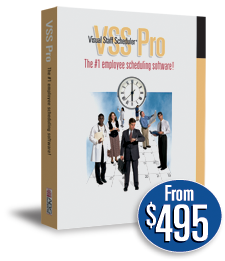
Employee Scheduling Software
End of Service Notice (4/1/2022): It has been our pleasure to provide our customers with quality PC software for over 30 years. As of 4/1/2022, all installable PC-based products and tools will no longer be available for sale. To help you transition to other solutions, we will continue to support these products through 3/31/2023. You can continue to use our products after 3/31/2023. Thank you for your business!
Choosing the Number of Schedule Files to Use in Employee Scheduling Software
If you’ve just bought employee scheduling software, you may be reviewing the steps to get started. The company you bought the software from may have told you that the first steps to starting your shift schedule include defining your shifts, defining explanations and coverage targets for those shifts, and then adding your employee names and information about them, such as the contact information, position, unique skills, and the number of hours they wish to work. But, before you can even start the set-up process, you need to decide how many schedule files you want to set up. There are two main approaches you could take: you could have one, master schedule file for the entire organization, or you could have separate, individual schedules for each department or unit within the organization.
Categories
Popular Tags
- write a business plan
- reports
- how to schedule
- Human Resources
- upgrade
- Employee Scheduling
- Appointment Scheduling
- customer review
- personnel records
- Business Planning
One Master Schedule File for Entire Organization
With one master schedule, you’ll add all your employees to one file. Within the file, you can set up dividers to separate your master schedule into individual departments. If every department works the same pre-defined shifts, you only have to define those shifts once and use them for each department.
If your employees work in multiple departments, i.e. they are not solely assigned to work in one particular department, then you’ll want to go with the approach of using one master file, so people can be used interchangeably in any area of your organization. Using one master file also gives you a broad, “birds-eye” view of your organization’s entire shift schedule.
Separate, Individual Schedules for Each Department or Unit
The other approach is to use separate, individual schedule files. To do this, you’ll need to create one schedule for each department or unit. Each file will contain a list of employees who work in that area only. You’ll need to define shifts in each file.
Using separate, individual files may be easier to work with if you’ve got a big list of workers and many departments, or if your organization has multiple schedulers. For example, if each department has their own set of staff members and its own team scheduler, it would be best for each scheduler to have control over their own file. This approach also gives managers a detailed view of their department.
As you can see, you need to figure out how many schedules files you want to use in your employee scheduling software before you can set them up! The main question you need to ask yourself to figure it out is “do our employees work throughout the entire company or does each unit operate with their own specific set of staff members?”